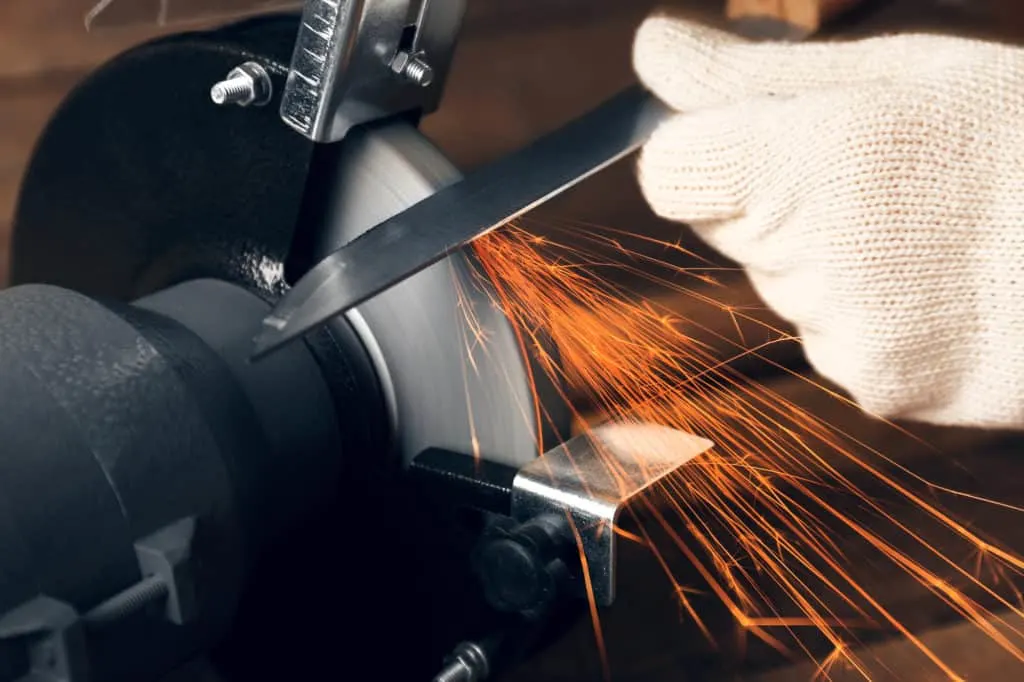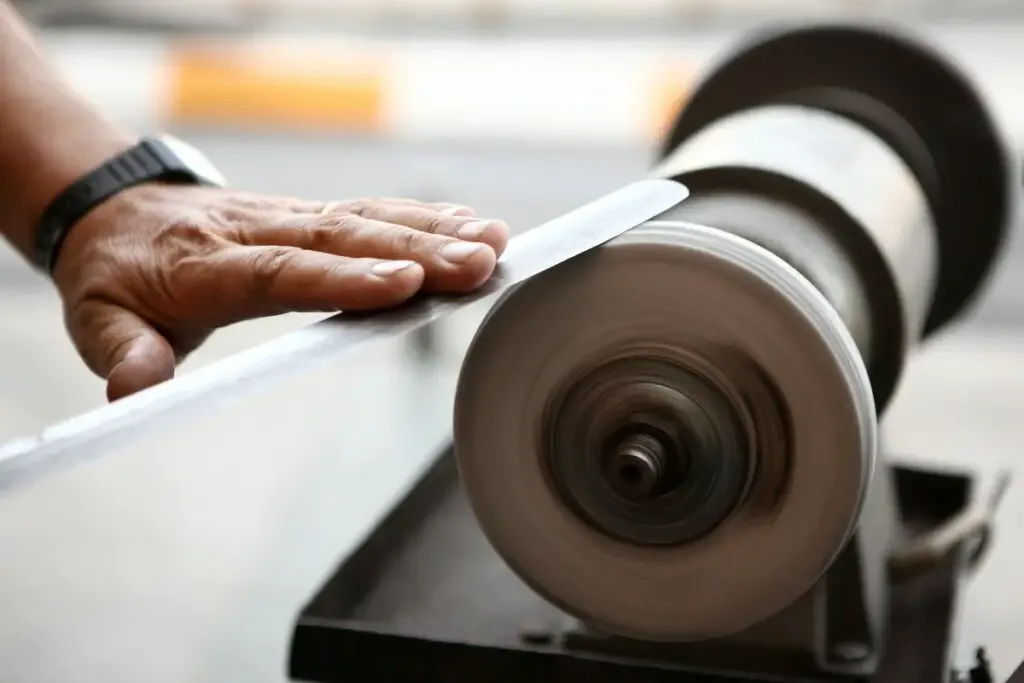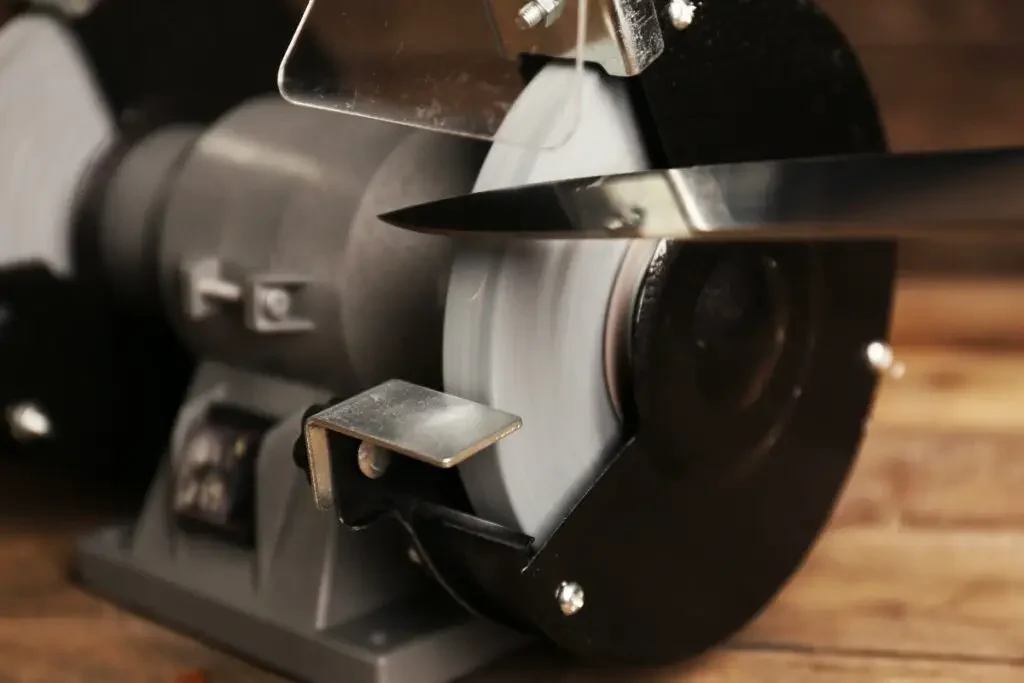As an Amazon Associate, we earn from qualifying purchases with no additional costs for you.
Knife sharpening is a vast topic, and people are always looking for ways to put an edge on a knife with the tools they have on hand or looking for faster, more efficient ways to get their knives sharp. A bench grinder is essentially a sharpening power tool that you can use to sharpen garden implements such as lawnmower blades and hoes, but can you use the bench grinder to sharpen a knife?
You can sharpen a knife with a bench grinder. You will be able to achieve a good edge with fine-grit grinding wheels, but these are not always easy to find. You could also modify your bench grinder with paper wheel attachments that will work better at putting a razor-sharp edge on your knife.
A bench grinder is often seen as a rough and ready tool that has very little finesse about it. It is normally used to put an edge on heavy-duty tools rather than a fine edge on something like a knife. It is somewhat similar to using a sledgehammer to drive in a nail! It may get the job done, but there could be some peripheral damage in the process!
If you are interested in checking out the best whetstones for sharpening your knives we recommend and use you can find them by clicking here (Amazon link).

Can You Sharpen A Knife With A Bench Grinder?
Most bench grinders come with two stone grinding wheels installed on the grinder. In most cases, the two stones will be of a different coarseness; a coarse grinding stone and a fine grinding stone.
On some grinders, the actual grit rating of the grinding stones may be indicated, but on others, this important information may be missing.
However, you will be able to tell just by looking at the two stones, which is coarse and which is fine, but you may not know the grit level. You can use these stones on your grinder to put an edge on a knife, but there is some information you need to know before you try this out.
- Safety
Always have safety in mind when sharpening a knife on a bench grinder, use eye protection.
- Watch the grinder spin direction
You should always approach the grinding stone with the stone spinning away from the edge of the blade. If the stone spins towards the sharp edge of the knife, it could catch on the edge of the knife and completely ruin the edge, or even rip the knife out of your grip and send it hurtling in your direction.
- Don’t let the knife get hot
You need to have a bucket of water on hand to dip the knife in to cool it down. If the knife gets too hot on the grinder, it will lose its hardness and temper.
- Don’t use too much pressure
A light touch of the steel to the grinder is all that is required. Pushing too hard into the grinder can be dangerous for you and can damage the knife.
- Watch your angle
It is crucial to maintain the same angle as you pull the blade across the surface of the grinding stone.
It is always best to sharpen your knife on a bench grinder with a fine-grit stone, but these are not available in all sizes, so the availability of a fine-grit stone will depend on your grinder and the parts you can source for it.
If you cannot source a fine grit stone, use the finest grit stone you have, but you will most likely need to do some extra finishing work on the blade.
TIP: If you want to sharpen your knives, but you are afraid of damaging them, you can use a sharpening system that will guide you through the sharpening process. Check out the guide in the article below:
Ultimate Guide: Best Knife Sharpening Systems for Beginners
How To Sharpen A Knife On A Bench Grinder

The coarse stone on a bench grinder is usually too coarse to be used to put an edge on a knife. This stone is normally only used if the edge of the knife is seriously damaged. Use the fine-grit stone to do your sharpening on.
Some people remove the guard over the wheel and sharpen the knife on top of the wheel rather than at the front of the grinding stone. This position gives better control of the angle of the knife on the stone.
Run a permanent marker or sharpie along the edge of the blade to put some color on the edge so that you can see if you are maintaining your angle correctly while sharpening.
- Approach the stone with the knife at the desired angle. Always make sure that the stone is spinning away from the edge of the knife, not towards it.
- Gently, with very little pressure, bring the edge of the knife into contact with the grinding wheel.
- Draw the length of the blade along the grinding stone, and maintain the same angle as you do so.
- Perform the same sequence on the other side of the blade.
- Check the edge to make sure you have the desired angle, and then perform another 3 or 4 passes of the edge across the grinding stone.
Once you have established a good edge on the knife, you can strop the knife on a piece of leather to polish and hone the edge.
If the coarseness of the stone has left the edge a little rough, you can fix this by taping some fine-grit sandpaper, something like 800 grit, to a hard, flat surface such as a granite countertop and using this to finish the edge like a whetstone.
While the stone grinding wheels will be able to sharpen your knives, in most instances, the stones are too aggressive and remove too much material. A better way to use your bench grinder is to get some paper wheel attachments for your bench grinder.
TIP: Another option on how to sharpen a knife without whetstone is using a file. Check out a step-by-step guide on how to sharpen a knife with a file in the article below:
How To Sharpen A Knife With A File? Follow These 7 Steps
Use Paper Wheel Attachments On Your Bench Grinder To Sharpen Knives
You can purchase paper wheel attachments for your bench grinder, which will turn your bench grinder into an extremely efficient knife sharpening machine.
The wheels normally come in a set of two, one which has a silicon carbide or diamond grit on the surface, and one which has nothing on the surface, but you will apply rouge to the surface.
The paper wheels are mounted on the grinder in place of the stone grinding wheels. The paper wheel with the grit on it is used to establish the edge on the knife. The paper wheel with the rouge or compound on it will be used to polish and refine the edge of the knife.
These two paper wheel attachments make it extremely easy to sharpen your knives on a bench grinder. The edge that the paper wheels put on the knife is also far superior to what you can achieve on the grinding stones.
The paper wheels are also less aggressive and remove less material, so if you make a mistake on the blade edge, it is less drastic than making a mistake with the stone grinding wheels.
BTW: If you want to know more about Japanese and other knives and their sharpening, check out the books listed above. These books are recommended by professional sharpeners and knife makers (Amazon links):
- Japanese Kitchen Knives: Essential Techniques and Recipes
- The Knifenerd Guide to Japanese Knives
- Knife: The Culture, Craft, and Cult of the Cook’s Knife
- Sharp: The Definitive Introduction to Knives, Sharpening, and Cutting Techniques, with Recipes from Great Chefs
Why Paper Wheel Attachments Are Superior

In knife sharpening, the tools and techniques employed can significantly affect the final result. While traditional bench grinders with stone wheels have their place, paper wheel attachments have emerged as a superior alternative for several reasons. Here’s why:
- Less Aggressive: Paper wheel attachments are generally less aggressive than stone grinding wheels. This means they remove less material from the knife, preserving its lifespan and ensuring that any mistakes made during sharpening are less drastic.
- Refined Edge: The paper wheels provide a much more refined and polished edge compared to stone wheels. The result is a sharper blade that offers smoother cuts and better performance.
- Versatility: Paper wheel attachments often come in sets, with one wheel coated in silicon carbide or diamond grit for sharpening and another for polishing and refining the edge. This dual-wheel system allows for a comprehensive sharpening process, from establishing the edge to honing it to perfection.
- Safety: The nature of paper wheels reduces the risk of the knife catching on the wheel and being thrown, a hazard sometimes associated with stone wheels. This makes the sharpening process safer for the user.
- Ease of Use: Paper wheels offer a more straightforward and intuitive sharpening experience for beginners and even seasoned sharpeners. The feedback from the wheel is more tactile, allowing users to feel the sharpening process more closely and make adjustments as needed.
- Consistent Results: Paper wheel attachments provide consistent results due to their design and material. Whether you’re sharpening a kitchen knife or a hunting blade, you can expect a uniformly sharp edge every time.
- Cost-Effective: While there might be an initial investment in acquiring high-quality paper wheel attachments, they tend to last longer and require less maintenance than traditional stone wheels. Over time, this can translate to savings both in terms of money and effort.
While traditional bench grinders have their merits, the introduction of paper wheel attachments has revolutionized the sharpening process. Their efficiency, safety, and ability to deliver superior results make them a preferred choice for many knife enthusiasts and professionals alike.
Conclusion
It is absolutely possible to sharpen a knife on a bench grinder with stone wheels. This method is very unforgiving and requires some time to master and achieve good results without ruining the knife. Even though it may be difficult to achieve, it is definitely possible.
There are easier methods to make use of your bench grinder to sharpen knives in a much easier and safer way. Paper wheel attachments can be purchased for most bench grinders.
These wheels are much easier to use for knife sharpening and are less aggressive in the amount of material that they remove.
Paper wheels are also safer to use, and the edge that you can achieve on the knife with these attachments is a much more refined edge than you can achieve on stone wheels alone.
TIP: The best way to sharpen a knife is using a whetstone. Check out the ultimate step-by-step guide on how to sharpen a knife with a whetstone in the article below:
Step-By-Step GUIDE: How To Sharpen A Knife With A Whetstone

